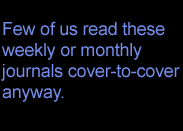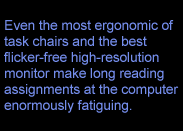|
By Joseph Conte I've been of a divided mind about my reading recently. It's an activity that's given me uncompromising, if solitary, pleasure for most of my life. So I'm a little concerned about changes that affect something that I do professionally and, even if I never got paid for it, out of personal interest. Much of the reading material that I enjoy has become available in more than one medium. I can take a comfortable walk to the cigar shop on the corner to buy a print copy of the Sunday New York Times, with its magazine and book review sections, or I can preview the electronic edition from my home computer by pointing my browser to http://www.nytimes.com/. Most other major newspapers in the country now have on-line editions. Several of the nationally circulated magazines that I receive by post are also available in some modified format (including to those who do not pay for subscriptions to the print version) on the Web. I can peruse the latest short story by John Barth, "Click," a spoof on the "hypertextuality of everyday life," over coffee and biscotti in The Atlantic Monthly, or read yet another opinion piece on the U.S. role in Bosnia in The New Republic. But the venerable Atlantic, possibly the oldest continually-published journal in America, has launched an e-zine version called Atlantic Unbound [http://www.theatlantic.com/], and the feisty, liberal New Republic is competing for readers on-line [http://www.thenewrepublic.com/] with its former editor, Michael Kinsley, who was hired by megalithic Microsoft to edit the e-zine Slate [http://www.slate.com/]. There are fairly obvious advantages
and disadvantages to these competing "delivery But what I, and the business managers of these journals, have to wonder is, why are publishers competing against themselves in digital and print media? And how does the competition between media affect my attention or the stamina required for reading? The answer to the first question can be had from any entrepreneur of controlled substances on the streets of America. A little free taste of the product brings them back for more. Although the feature columns of mass market weeklies can hardly be described as addictive, the presumption is that those who actively search out the contents of Time or Windows magazine are fairly good candidates to passively receive an entire year's subscription to the product. The statistical sampling is probably quite low, but then the response rate on credit card offers through the mail is less than two percent, and the banks do all right. Michael Joyce, a novelist and co-designer
of the hypertext writing program Storyspace, has called hypertext the revenge
of print on television. Well enough, since a How does this bode for book-length works like the novel? Proponents of digital media have been prophesying an imminent transition from print to electronic texts. Jay Bolter has called our time the "late age of print." And novelist Robert Coover announced "The End of Books" in his review of hypertext fictions in 1993. The cost of producing sixty thousand CD-ROMs is cheaper than an equivalent number of hardcover books. The computers on which those CDs are "read" have nearly reached a market penetration in American households comparable to the microwave oven or the VCR. Owning a computer, preferably one for each member of the family, will soon be a requirement of a middle-class lifestyle. But the transition from print to electronic
texts, especially for the novel, The innovative writers whose work defined American postmodern literature since the 1960s learned their trade before the advent of the personal computer. Don DeLillo, whose latest novel Underworld refers to a web site for miracles, has said that he cannot compose without the physical clack of typewriter keys against the page. John Barth amuses himself at the expense of those who only point and click, but writes, he professes, with a MontBlanc pen and a sheaf of loose leaf in a spiral binder. No amount of hotlinked wizardry will keep the information age client glued to their computer screen. Only when the imaginative verve--which has little to do with computer savvy-that our most important writers possess has been brought intrinsically to the hypertext environment will reading a novel on CD-ROM seem both compelling and natural. In the meantime, postmodern novelists
such as William Gibson, Kathy Acker, Richard Powers, and David Foster Wallace,
though still bound to the Write "Ellavon" at ellavon@ellavon.com.
Released: January 31, 1998 |

 systems" (a favorite piece of jargon employed recently by the FDA
to describe the cigarette as a dispenser of nicotine). If one sets aside
the "start-up" costs of owning a multimedia computer, the relatively
modest cost of on-line access to hundreds of e-zines and journals offers
real incentive to the casual reader to surf favorite magazines. Few of
us read these weekly or monthly journals cover-to-cover anyway. Who doesn't
have a stack of partially read magazines in whatever room in the house
where you're most relaxed? And the price for browsing, whether at Borders
or on the Web, is right. Most on-line newspapers and magazines offer free,
although sometimes limited, access to content, that is subsidized in part
by advertisements. (Slate, by the way, is in the process of converting
to a paid-subscription basis, like such business-oriented publications
as The Wall Street Journal). But clearly the most important feature of
the digital newsstand is that its contents are searchable. That virtually
anyone, with a modest formal education, can run powerful searches and collate
results from several years' worth of published archives, has profound implications
for an egalitarian society in which access to information is power.
systems" (a favorite piece of jargon employed recently by the FDA
to describe the cigarette as a dispenser of nicotine). If one sets aside
the "start-up" costs of owning a multimedia computer, the relatively
modest cost of on-line access to hundreds of e-zines and journals offers
real incentive to the casual reader to surf favorite magazines. Few of
us read these weekly or monthly journals cover-to-cover anyway. Who doesn't
have a stack of partially read magazines in whatever room in the house
where you're most relaxed? And the price for browsing, whether at Borders
or on the Web, is right. Most on-line newspapers and magazines offer free,
although sometimes limited, access to content, that is subsidized in part
by advertisements. (Slate, by the way, is in the process of converting
to a paid-subscription basis, like such business-oriented publications
as The Wall Street Journal). But clearly the most important feature of
the digital newsstand is that its contents are searchable. That virtually
anyone, with a modest formal education, can run powerful searches and collate
results from several years' worth of published archives, has profound implications
for an egalitarian society in which access to information is power.  good deal of Web "browsing" requires that the browser read the
screen text and interact with the source by making a number of choices
between linked "lexia." Television, still the nation's babysitter,
requires only passive, visual attention-channel-changing remotes notwithstanding.
Will the digital medium of CD-ROM and on-line communications offer a lush
new garden for the writer to explore? Will on-screen reading revive the
shrinking numbers of dedicated readers? I think the answer is yes, but
only in the genres that Edgar Allan Poe would have admired for their brevity:
short stories, reviews, news articles, essays, and remarkably enough, poems
(especially those that utilize the spatial, typographical, and shifting
qualities of the screen). In short, the stuff of magazines and newspapers.
Even the most ergonomic of task chairs and the best flicker-free high-resolution
monitor make long reading assignments at the computer enormously fatiguing.
And there are never any software glitches with print media.
good deal of Web "browsing" requires that the browser read the
screen text and interact with the source by making a number of choices
between linked "lexia." Television, still the nation's babysitter,
requires only passive, visual attention-channel-changing remotes notwithstanding.
Will the digital medium of CD-ROM and on-line communications offer a lush
new garden for the writer to explore? Will on-screen reading revive the
shrinking numbers of dedicated readers? I think the answer is yes, but
only in the genres that Edgar Allan Poe would have admired for their brevity:
short stories, reviews, news articles, essays, and remarkably enough, poems
(especially those that utilize the spatial, typographical, and shifting
qualities of the screen). In short, the stuff of magazines and newspapers.
Even the most ergonomic of task chairs and the best flicker-free high-resolution
monitor make long reading assignments at the computer enormously fatiguing.
And there are never any software glitches with print media.  won't be complete until there has been at least one great author for whom
electronic composition is the preferred medium. That author would exploit
all of the intrinsic capabilities of a linked, multimedia text, so that
"reading" the work would make use of a computer indispensable.
There are a few talented authors composing almost exclusively for hypertext
environments. But none have quite matched the fictive power of a John Barth,
Italo Calvino, Julio Cortázar, Don DeLillo, Georges Perec, or Christine
Brooke-Rose--each of whom anticipated hypertext linking and nonlinear narrative
in their fiction-in the electronic medium.
won't be complete until there has been at least one great author for whom
electronic composition is the preferred medium. That author would exploit
all of the intrinsic capabilities of a linked, multimedia text, so that
"reading" the work would make use of a computer indispensable.
There are a few talented authors composing almost exclusively for hypertext
environments. But none have quite matched the fictive power of a John Barth,
Italo Calvino, Julio Cortázar, Don DeLillo, Georges Perec, or Christine
Brooke-Rose--each of whom anticipated hypertext linking and nonlinear narrative
in their fiction-in the electronic medium.  print order, provocatively engage the terms and conditions of the information
age. Their writing manages to invoke the cascade of associative thought
that characterizes the experience of the Internet. As commercial "properties"
themselves, they have collaborated on web pages with digital artists and
publishers, or are the subjects of scholarly sites and more broadly-appealing
discussion lists. We may have entered a period of transition, but the novel
hasn't yet become obsolete.
print order, provocatively engage the terms and conditions of the information
age. Their writing manages to invoke the cascade of associative thought
that characterizes the experience of the Internet. As commercial "properties"
themselves, they have collaborated on web pages with digital artists and
publishers, or are the subjects of scholarly sites and more broadly-appealing
discussion lists. We may have entered a period of transition, but the novel
hasn't yet become obsolete.